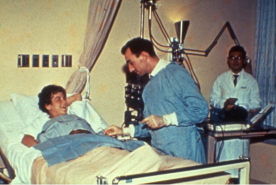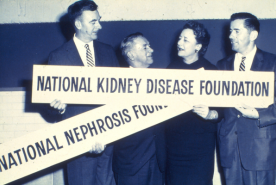About
When you’re on the waitlist for a kidney transplant, understanding the types of kidneys available can help you make informed decisions. You may already know about several types of kidneys that people with kidney failure can get today, including from a:
- Living donor, either someone you know, someone anonymous, or through a paired-exchange program
- Deceased donor
But you may not have heard about kidneys that are considered underutilized. There are not enough donor kidneys for all the people with kidney failure who need a kidney transplant – so you should know that an underutilized kidney may be a good option for you to consider.
Underutilized kidneys have something about the kidney or the donor that is less than perfect but can still work well. Saying “yes” to one of these kidneys can potentially improve your chances of getting a kidney sooner and may be a better choice than staying on dialysis. You will need to provide written consent to the transplant center if you would like to consider these kidneys, and you can change your mind at any time – so ask a lot of questions and keep talking to your healthcare team even after you have been added to the transplant waitlist.
There are two main kinds of underutilized kidneys:
- High Kidney Donor Profile Index (KDPI)
- Increase Risk of Disease (IRD) Kidneys.
Both types can be good options for some patients and may be a better choice than staying on long-term dialysis or waiting a long time on the waitlist.
While high KDPI or IRD kidneys might not be your first choice, accepting them for your transplant may offer some important benefits, including:
1.You may be able to get a kidney transplant faster.
2.For many people, these kidneys function very well for a long time.
Let’s start with high KDPI kidneys by looking at how donor kidneys are categorized.
KDPI
The Kidney Donor Profile Index (KDPI) is a scoring system that ranges from 0 to 100. This score, which is based on certain guidelines, rates how well a donor kidney is expected to work compared to the kidneys that were transplanted in the previous year. This score is based on several things that are known about the person who donated the kidney, like their age, height, weight, and health history. A lower KDPI score means that the donor kidney is expected to work longer (10-15 years), and a higher KDPI score means that the donor kidney is expected to work for a shorter time (7-10 years).
Understanding Kidney Donor Profiles: A Patient's Guide
| Low KDPI (Score under 20) | Medium KDPI (Score 20 to 85) | High KDPI (Score over 85) | |
| Description | Kidneys from younger or healthier donors. | ||
| Expected Kidney Lifespan | About 10 to 15 years | About 10 to 15 years | About 7 to 10 years |
| Typical Recipients | Patients who might benefit most from a longer-lasting kidney | Suitable for a broad range of patients | Patients needing a transplant more urgently |
| Additional Notes | Shorter waiting times, but more competition for these kidneys | Balance between availability and waiting times | Often available more quickly, beneficial for patients with fewer options |
High KDPI Kidneys
The KDPI score plays a key role in the kidney-matching process. Kidneys with a low KDPI score are usually given to people who are expected to live a long time with their new kidney. These patients often include younger people, people who have not had a transplant before, and those who have spent less time on dialysis.
One category of underutilized kidneys are those with a high KDPI score, which means the score is over 85. It is important to know that these kidneys are likely to function for many years and may be a good alternative to staying on dialysis for patients who are older, have been on dialysis a long time, or have other health concerns that make it harder to receive a kidney transplant.
IRD Kidneys
Another category of underutilized kidneys is from donors who are at an increased risk of disease (IRD). This includes people who have died from drug overdoses, which is becoming more common due to the opioid crisis. These kidneys, like all kidneys, go through a lot of testing to make sure they’re safe enough to transplant. Also, every transplant team is required to talk to each patient about the possible risks of accepting these kidneys.
Over the years, research has shown that IRD kidneys have similarities to typical kidneys, including:
- IRD kidneys last a similar amount of time.
- IRD kidneys have about the same rate of delayed graft function, which is when a kidney transplant does not work right away
- IRD kidneys have about the same rate of rejection after transplantation
- Patients who get an IRD kidney live about the same amount of time
- In one study, the 10-year survival rate was 72.7% for people who had a hepatitis C kidney transplant, compared to 76.5% who did not receive a hepatitis C kidney.
Antiviral Treatment Is Effective
You may have concerns about the lifestyle of some IRD kidney donors, but research shows that kidneys from drug overdose donors can work just as well as kidneys from donors who died from other causes, such as accidents or violence.
While rare, viral infections like hepatitis C from an IRD kidney are possible. If you contract a disease like hepatitis C from an IRD kidney, it is highly treatable.
Antiviral medications can cure hepatitis C in most cases, with a success rate of 97.1% to 99.3%.
Tools
The Johns Hopkins IRD Kidney Transplant Calculator is a tool is designed to help you understand your options when considering a kidney transplant from an IRD kidney. Using this calculator can help you make informed decisions about moving forward with an IRD kidney. The Scientific Registry of Transplant Recipients also has a tool to help you find a transplant center for patients like yourself that includes options for high KDPI, IRD, and hepatitis C positive kidneys.
High KDPI/IRD Kidney Process
Getting one of these kidneys is completely up to you. On the donor side, many tests for each donor kidney that is available. On the patient side, there are a few steps, which include giving your written consent to the transplant center where you are planning to receive a transplant. You must give your written consent to the transplant center before you can be considered for high KDPI or IRD kidneys. You can change your mind at any time about getting a high KDPI or IRD kidney, so talk to your transplant team if you have any questions.
Written Consent
For high KDPI and IRD kidneys, transplant centers require written consent from potential recipients. This is an ethical and legal requirement to ensure that you are fully aware of the risks and benefits associated with these types of kidneys. The transplant center will educate you about the risks and benefits, and then you will be given a form to complete. Take your time and ask as many questions as you want. It’s important to know that even after signing the consent form, you can revoke (remove) your consent, which means you can change your mind and take back your permission at any time, for any reason, without any problems.
After you’ve given your written consent, it will be entered in your medical record, and you will be considered for high KDPI and IRD kidneys in addition to low and standard KDPI kidneys. This can potentially shorten your time on the waiting list and improve your chances of receiving a kidney sooner. Remember, you can change your mind at any time.
Keep the Conversation Going
Remember, talking to your transplant team about high KDPI and IRD kidneys is not a one-time event but an ongoing conversation. Your health status can change, and so can your transplant team’s recommendations. Continue asking questions and talking with your team so you can make the best decisions.
Questions to Ask
My Health Status:
- Based on my current health, what are the pros and cons of accepting a high KDPI or IRD kidney?
- How would a high KDPI or IRD kidney interact with my other health issues, such as diabetes or high blood pressure?
- What extra tests or screenings would I need to have to get a high-KDPI or IRD kidney?
Transplant Center Practices
- What is your transplant center's average wait time for a high KDPI or IRD kidney? What is the average wait time for other kinds of kidneys?
- How does your center’s success rate with high-KDPI and IRD kidneys compare to national averages?
- Can I talk to other patients from your center who have gotten high KDPI or IRD kidney transplants?
Care After Transplant
- What special care programs are available for patients after they receive these types of kidneys?
- How does your center manage any complications that may come up after the transplant?
Financial and Insurance Considerations
- Does my insurance cover the specific treatments and extra medications that may be needed for a high KDPI or IRD kidney?
- Are there any additional costs associated with accepting a high-KDPI or IRD kidney?
Ongoing Communication and Support
- Who can I contact if I have more questions about this?
- How can I stay updated on new research or changes in guidelines that might affect my transplant options and decisions?
This content is provided for informational use only and is not intended as medical advice or as a substitute for the medical advice of a healthcare professional.

















